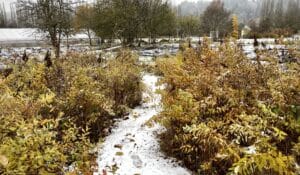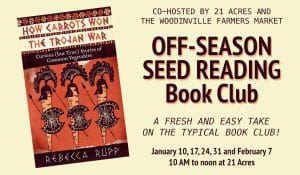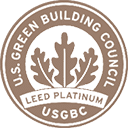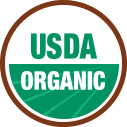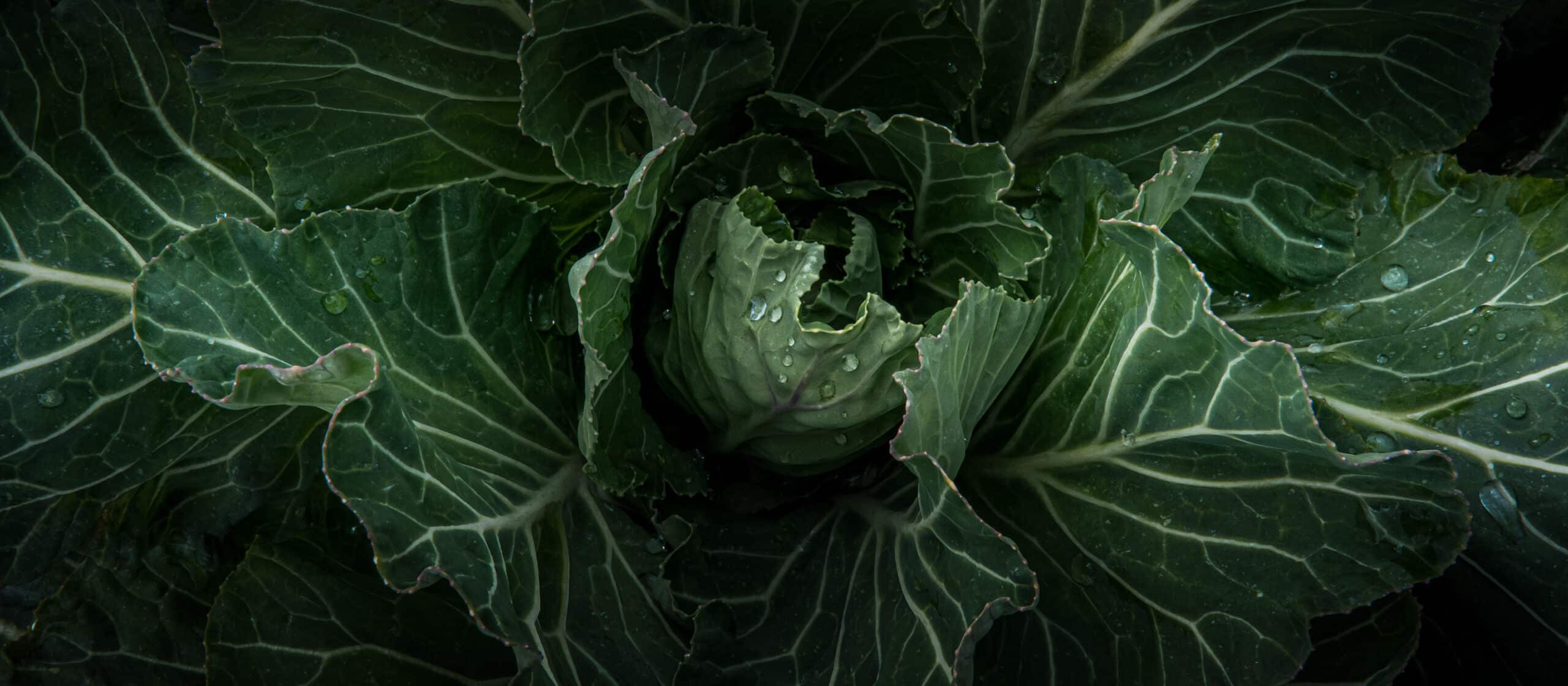
Compost, Recycling, or Landfill? Digging through the 21 Acres Waste Stream
Compost, Recycling, or Landfill? Digging through the 21 Acres Waste Stream
- posted on: October 12, 2021
- posted by: Rebecca Jordan
"*" indicates required fields

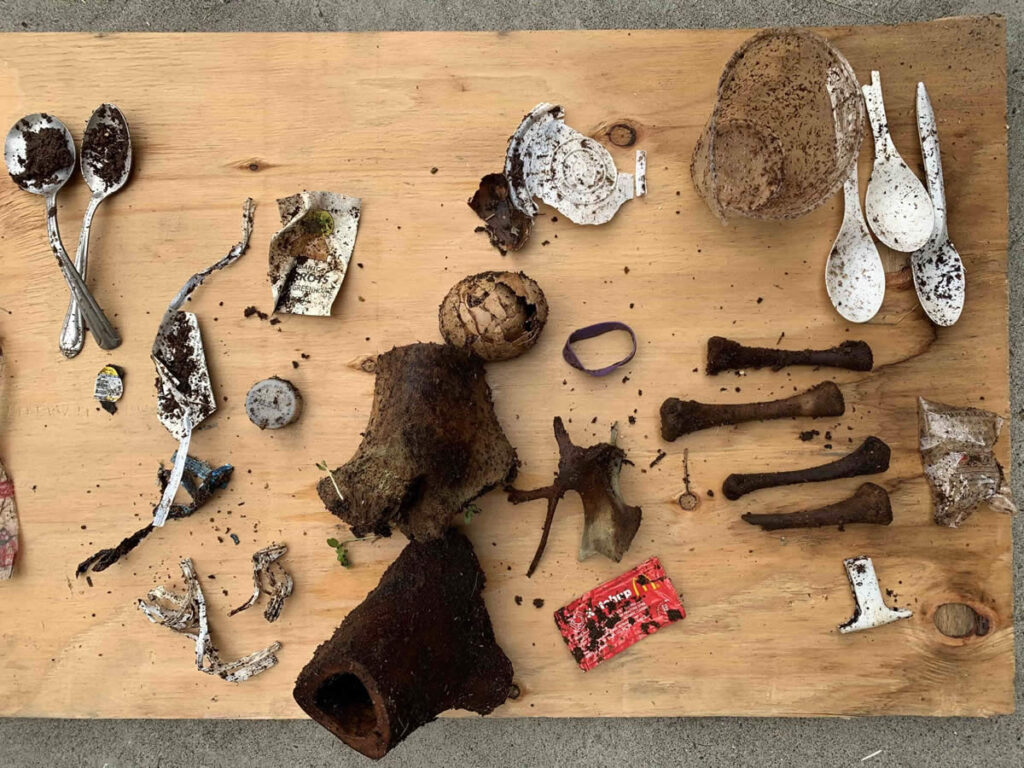
This article was written by Kelly Rankich, Facility Manager, and Becca Jordan, Operations Manager.
Hi all — Kelly Rankich here. I’m the Facilities Manager at 21 Acres and we strive to operate as close to a zero-waste campus as possible. This means that I get to do a lot of dumpster diving, making sure that things that are recyclable or compostable don’t end up in the landfill.
I also do a lot of education — for our team here, for volunteers, and for visitors. In my continual quest to learn the science behind our waste stream, I recently took a look at what’s in our compost. Here’s what I’m discovering about food waste, compostable packaging, recycling, and the way that our campus sorts through all kinds of waste that our work produces.
Landscape Waste
If you spend any amount of time on 21 Acres, it’s likely that you’ve pulled a weed or two. I certainly have! You’d think that these would all go straight into compost, right? The truth is more complicated.
Yes, we compost non-invasive weeds. We also compost invasive plants such as blackberry and reed canary grass—but because invasives have proven themselves to be resilient, persistent, and threats to native plants and animals, they get their own compost piles on the farm. My colleague Jess Chandler set up invasive compost piles last year with a solar-powered wind tunnel to help them decompose faster. Watch these videos to learn more about how it works.
Reducing Food Waste Onsite
An estimated 30 to 40 percent of food is wasted globally. This not only contributes to food insecurity; it also creates greenhouse gas emissions when food goes to landfills and decomposes improperly. Worldwide, the solution looks like improved food storage and transportation options to make food last longer and get to communities that need it the most.
Long story short: If someone can eat it, it’s not waste.
On our campus, before food even has a chance to go to waste, we partner with FareStart. Their gleaners come to the farm to glean mostly berries and apples that simply exist on the farm and won’t be harvested anyway. This helps make sure that the fruit is going to people who could use the food and also reduces the risk of blackberries going to seed and creating more invasives we’ll have to tackle later.
For the food that is harvested, bought, and sold in the Farm Market, our Deli Lead Kari Fetrow first works to save any ingredients she can use for the next week’s menu. (That’s part of why our seasonal menu is always changing!)
Next, we share produce that is in danger of becoming food waste with area food banks (primarily Woodinville Storehouse across the street from our campus).
Now, there’s always food that might be past its prime for humans to eat. But our goats and seasonal pigs here on the farm always enjoy a snack—and they’re not nearly as picky as we are. Our Farm Market team makes sure they are well fed with produce scraps.
When everybody has had their fill and all that’s left is inedible food scraps, that’s not the end of the waste cycle—these scraps don’t churn out the same carbon emissions that are a result of food
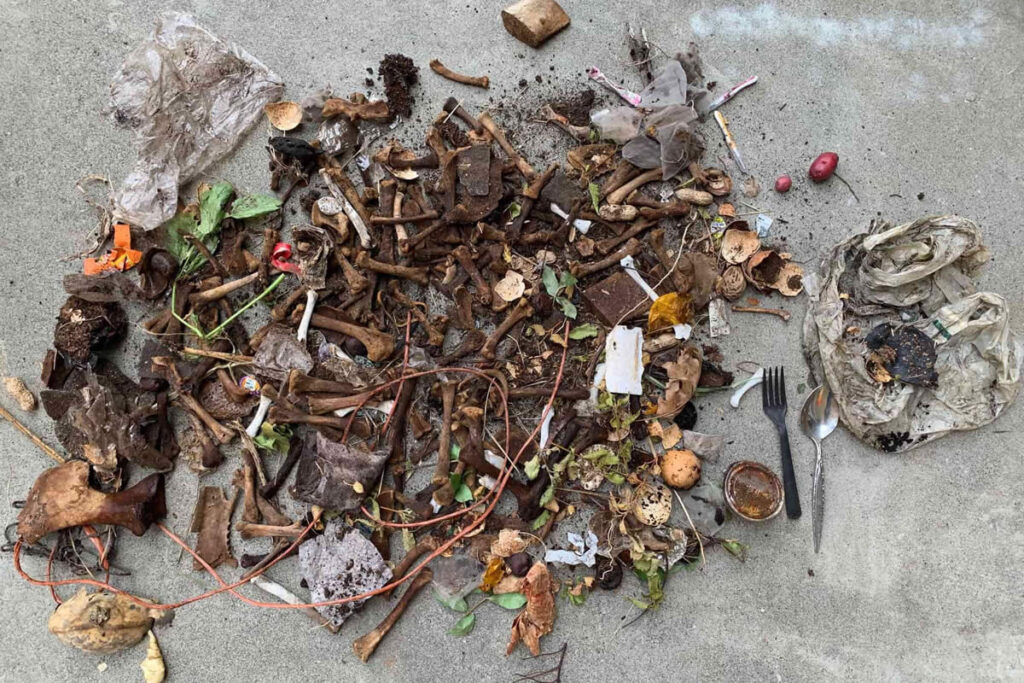
decomposing unnaturally in a landfill. Our onsite compost bays churn this food over the course of about 6 months into soil—nutrient-rich soil that we then use on the farm, closing the loop of the soil cycle.
This summer, we found that we had to adjust the way that we were composting food on site. Meat, bones, dairy, and oil are no longer going into the compost bays here—we’ve found that bones just don’t break down fast enough for us to be able to use it on the farm, and the meat and dairy tends to attract pests.
But meat and bones still have their place in the waste cycle. When these methods of reducing food waste onsite and in the community don’t meet the mark, we’ll next look at commercial composting.
Commercial Composting and Compostable Packaging
There’s a reason you don’t drop your plant-based packaging into your garden composter. These materials are sturdy enough to last a while (though thankfully not as long as plastic). Commercial composting has the capacity to break down this material much faster with high temperatures and added microbes, enabling it to become soil and re-usable more quickly.
Some examples of things you’ll see in our bins destined for Cedar Grove are deli containers, food-soiled paper or cardboard, packaging that we receive bulk foods in, those bones we mentioned earlier, and teabags. (Note: Always do your research before tossing those teabags. Most teabags contain microplastics and can damage anything trying to grow in the soil after it’s composted.)
What about those biodegradable containers that are common in Seattle? Composting facilities provide lists of the materials they can accept, determined after they’ve been tested.
However, in the United States, there has not been a clear labeling system established to determine if products, packages, and containers are compostable (or biodegradable). It’s confusing for both the consumer and employees at sorting facilities.
Enter Washington State ESHB 1569 which has been signed into law and took effect July 2020.
This law authorizes the state’s attorney general and local governments to pursue false or misleading environmental claims and “greenwashing” for plastic products claiming to be “compostable” or “biodegradable” when in fact they are not. This law requires that any container that was labeled as compostable or biodegradable had to be certified by a third party as being made of wood or fiber substrate, and must include readable and easily identifiable labeling.
It’s a big win for guests at 21 Acres to be able to quickly identify which bin to toss waste into, and will hopefully reduce the amount of confusion at composting facilities.
Still, compostable containers are complicated. While many containers are made from plants, such as PLA (polylactic acid) that is a common plastic substitute made out of corn, they are also the byproduct of industrial GMO and monocropped farms that produce soy and corn. As a result, they may contain pesticides and be an unknown variable on commercially composted soil.
Whenever possible, reusable containers made from glass and porcelain remain the most sustainable choice.
Recycling
Is there anything more confusing than recycling? There are the expected items that go straight into the bin: paper, cardboard, metal, glass bottles, and jars.
With plastic containers, it gets complicated. Plastic lids must be attached, although this rule changes frequently. Unless, of course, they are made of a different material from the container, in which case they should be separated. (Whether or not it can be recycled also depends on the size of the lid). Most plastic containers are a-okay as long as they are washed and dried first (water can contaminate paper products in the recycling bin). But those shaped like clamshells aren’t recycled here at our local Waste Management. Luckily, we can keep labels and tape on recyclables, making the job of sorting much easier.
Most commercial recycling won’t allow you to recycle plastic bags and flexible plastic film. But here at 21 Acres, we save them anyways—and then take them to the King County Shoreline Transfer Station, at local grocery stores that offer plastic film collection areas, and through Ridwell.
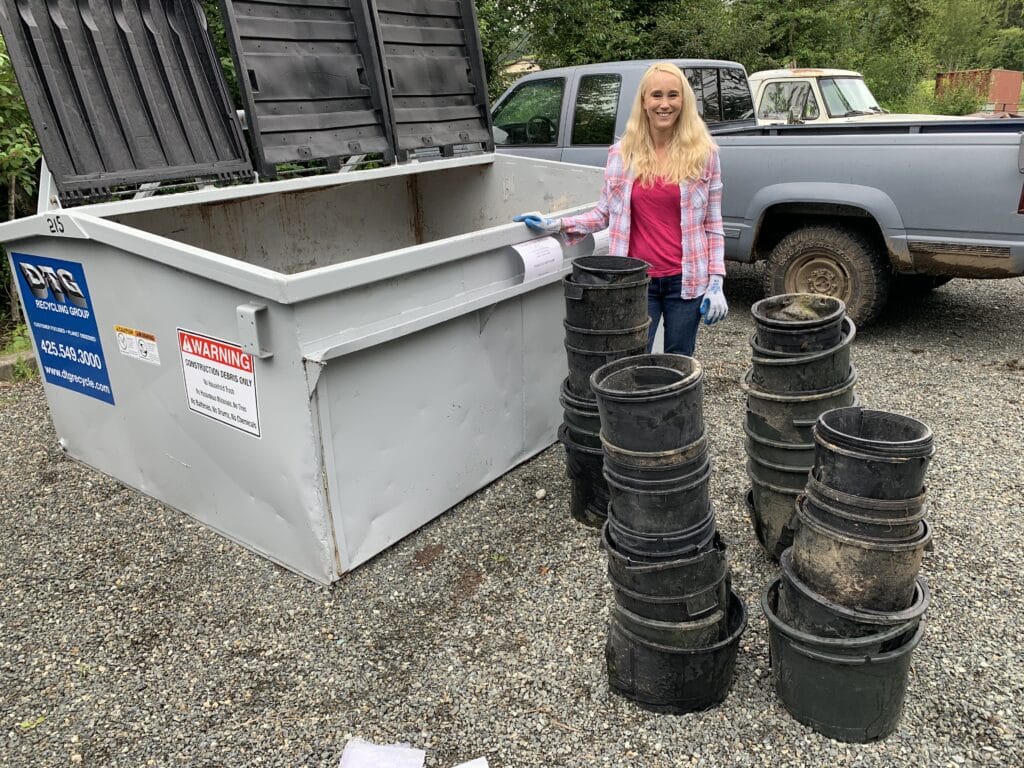
Packing materials are also hard to recycle. Styrofoam is not recyclable and is the bane of landfills everywhere. So we collect packing materials such as packing peanuts and bubble wrap and take them to a local shipping store who is happy to reuse them. It’s an imperfect solution, but it does keep plastics out of the landfill. Styrofoam is collected and either taken to the Shoreline Transfer Station or straight to StyroRecycle, in Kent, for recycling.
Then there are the agricultural waste materials that can really add up—especially as farmers have such little time and resources to sort and haul materials even if they are recyclable. Last year, we hosted two recycling events with DTG to help farmers collect hard-to-recycle materials, such as plastic irrigation tape and coverings.
We also handle special recycling with care, including light bulbs, batteries, and paint. Light bulbs and batteries are collected at most hardware stores and Paint Care started a new program for collecting latex paint.
Landfill
For larger items like bowls and plates, furniture we’re no longer using—we can keep those out of the landfill by donating to community members who can find a use for them or to thrift stores.
Even though many items are not able to be reused, composted, or recycled here, landfill is always our last resort option.
Wrapping Up on Waste
Does sorting all this waste really have an effect?
As part of our US Green Building Council LEED re-certification process, we recently conducted a waste audit. The purpose of the audit was to determine the percentage by weight of waste diverted out of the landfill over the course of a regular week. The audit determined that we diverted 90 percent of our waste from going to a landfill. There was a large pumpkin included in this math (definitely not usual for our waste stream), but even without it, we still diverted 86 percent of our waste.
The many arms of our waste stream might look different from yours. King County’s guidelines differ widely from other areas of the country. Even though Washington State ESHB 1569 lays out guidelines on compostable containers for Washington State, local cities and municipalities are mainly still responsible for how residential and commercial waste is managed. The only way to know for sure is to look up the guidelines for your city, or to call up your recycling facility to find out more about the items they accept.
Curious about what our waste stream looks like in practice? Join us on our next Green Building Tour.
Print this article: Compost, Recycling, or Landfill?About Kelly Rankich
Kelly is a Green LEED Associate and our Facility Manager. She helps operate and maintain our living laboratory for green building and supports our soil team, market, and various programs. She has a passion for sustainability and reducing her carbon footprint. She is a long-time Woodinville resident, raising her two kids in this community, and is enjoying not having a commute. She grew up on a small 6-acre farm in Wisconsin and completed her MS in Environmental Engineering at Washington State University. She is a proud WSU Snohomish County Extension Sustainable Community Steward. You may catch her giving a Green Building Tour, multi-tasking ten projects at once, or helping set up for an event. When not working, she enjoys the plethora of wineries in Woodinville, music, dancing, and yoga.
About Becca Jordan
Becca Jordan is our Operations Manager at 21 Acres. Becca connects with visitors and keeps 21 Acres communications running smoothly. She has a variety of background experience, from science fiction writing and art to education, technical theatre, and costume design to horse care. She’s passionate about learning new things about the natural world and social and climate justice. In 2015 Becca participated in the Clarion Writer’s Workshop and graduated with an MFA from California Institute of the Arts in 2016. Becca originally hails from Escondido, California. Her favorite parts of the Pacific Northwest are the ancient trees and the plethora of life around every corner.










 back to blog overview
back to blog overview


